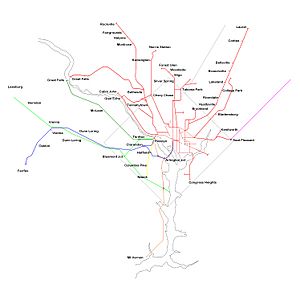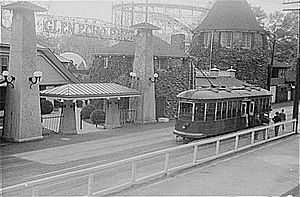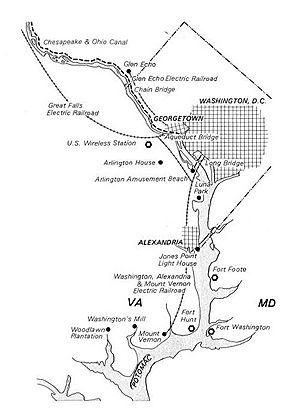Streetcars in Washington, D.C., and Maryland facts for kids
Streetcars and interurban trains were a popular way to travel in the Maryland areas near Washington, D.C., from 1890 to 1962. These electric trains, often called trolleys, helped people move around before cars became common.
Many of these train lines in Maryland started as separate companies. They often had big plans, but most struggled to make enough money. Eventually, a company called DC Transit owned or leased all of them. Unlike some other trolley lines, the Washington and Maryland lines worked together as one big system. However, as more people bought cars and the economy faced tough times, these streetcar lines slowly disappeared.
Contents
- Old Streetcar Companies
- Rock Creek Railway
- Tennallytown and Rockville Railroad
- Glen Echo Railroad
- Washington and Great Falls Electric Railway
- City and Suburban Railway
- Washington, Woodside and Forest Glen Railway Power Company
- The Kensington Railway
- The Baltimore and Washington Transit Company
- The Washington, Spa Spring and Gretta Railroad Company
- Washington and Great Falls Railway and Power Company
- Interurban Lines
- Trolley Parks
Old Streetcar Companies
Rock Creek Railway
The Rock Creek Railway was one of the first electric streetcar companies in Washington, D.C. It started in 1890. This line grew and eventually ran from the Cardoza/Shaw area in D.C. all the way to Chevy Chase Lake in Maryland. In 1895, it joined with another company, the Washington and Georgetown Railroad Company, to form the Capital Traction Company.
You can still find parts of this old line today:
- The waiting station at Chevy Chase Lake was moved in 1980 to Hyattstown, Maryland.
Tennallytown and Rockville Railroad
Three different streetcar companies worked together to provide service from Georgetown, D.C., up to Rockville, Maryland. The first was the Georgetown and Tennallytown Railway, which started in 1890. It ran from M Street NW up to Wisconsin Avenue NW to Tenleytown.
In the same year, the Tennallytown and Rockville Railway began building tracks from Tenleytown to Friendship Heights and the Maryland state line. Later, in 1897, the Washington and Rockville Electric Railway extended the tracks into Maryland, reaching Bethesda and Rockville. These companies eventually became part of the Washington Railway and Electric Company. By 1935, buses replaced the streetcar service on this route.
Glen Echo Railroad
The Glen Echo Railroad opened in 1891. It ran about 2.5 miles from Wisconsin Avenue west to Macarthur Boulevard. This line connected the Tennallytown and Rockville Railroad's end point near Friendship Heights to a train storage and power building.
In 1896, the company changed its name to the Washington and Glen Echo Railroad. It extended its line further west through Glen Echo to Cabin John. The railroad also extended its line east to Chevy Chase Circle, connecting with another streetcar line.
The Glen Echo Railroad stopped operating in 1902. However, part of its line was used by another company, the Washington and Great Falls Electric Railway.
You can still see parts of the old line:
- Railroad tracks and a bridge site are visible in Willard Avenue Neighborhood Park in Bethesda, Maryland.
Washington and Great Falls Electric Railway
The Washington and Great Falls Electric Railway Company (WGFERC) started in 1895. It ran from Georgetown, D.C., along the Washington Aqueduct to Glen Echo, and then along the old Glen Echo Railroad tracks to Cabin John. Because it ended at Cabin John and never reached Great Falls, it was often called the "Cabin John Trolley."
In 1902, the WGFERC bought several other streetcar lines and changed its name to the Washington Railway & Electric Company (WREC). This trolley line to Cabin John stopped running in 1960. You can still see the path of the old tracks in The Palisades and Montgomery County, Maryland.
Parts of the line you can still find in Montgomery County:
- An old bridge over Walhonding Brook.
- A bridge over Minnehaha Branch near Glen Echo Park. This bridge was fixed up in 2014 for a bike path.
- A bridge over Braeburn Branch.
- Much of the old path from Brookmont to Cabin John Parkway still exists.
City and Suburban Railway
The City and Suburban Railway started in 1890. It planned to run a streetcar from near the White House in D.C. to Mount Rainier, just over the D.C. border.
The line reached Mount Rainier in 1897. It then merged with another company and continued building tracks, reaching Brentwood in 1898 and Hyattsville and Riverdale in 1899.
Another company, the Maryland and Washington Railway, also planned a line to Branchville and Laurel. This company struggled and merged with others, eventually becoming the Washington, Berwyn and Laurel Electric Railroad Company. It extended tracks from Riverdale to College Park and reached Laurel by 1902.
Eventually, the City and Suburban company took control of the Washington, Berwyn and Laurel line. Later, the Washington Railway and Electric Company took over the City and Suburban.
The City and Suburban line had stops in these towns:
- Hyattsville
- Riverdale
- College Park
- Lakeland
- Berwyn
- Branchville
- Beltsville
- Contee
- Laurel
You can still find parts of this old line:
- Stations:
- 4701 Queensbury Road, Riverdale Park
- 531 Main Street, Laurel, which is now a restaurant.
- Roads:
- A bus turnaround north of Rhode Island Avenue and 34th Street in Mount Rainier used to be a streetcar turnaround.
- Trails:
- The College Park Trolley Trail follows part of the old route.
Washington, Woodside and Forest Glen Railway Power Company
The Washington, Woodside and Forest Glen Railway, also known as the "Forest Glen Trolley," opened in 1897. A ride cost five cents. This streetcar ran from Eastern Avenue and Georgia Avenue along Georgia Avenue and then along what is now Seminary Road to the National Park Seminary, a school for girls in Forest Glen.
This line faced competition from regular train service. It closed on December 15, 1924, because of construction for an underpass (a tunnel under the railroad tracks). Even though the underpass was built with space for the trolley, the trolley never started running again.
Stations on this line included:
- Silver Spring
- Sligo
- Woodside
- Forest Glen
The Kensington Railway
The Chevy Chase Lake & Kensington Railway started operating in 1895. It ran from the end of the old Rock Creek Railway at Chevy Chase Lake along Connecticut Avenue north to a station in Kensington.
Later, the line was bought and renamed the Kensington Railway. It was extended several times, reaching its longest point in 1916. From 1923 to 1933, another company, Capital Traction, leased the line. The Kensington Railway ran its last car on September 15, 1935. When the southern part of the line was replaced by buses, the railway lost its power source and stopped operating for good.
The path of the old railway was later turned into Kensington Parkway. An old bridge over Rock Creek was taken down, but its stone supports can still be seen.
The Baltimore and Washington Transit Company
The B&W Transit Company started building an electric street railway system in 1897. This line, known as the "Dinky Line," began in Washington, D.C., and went into Maryland. It continued along Ethan Allen Avenue until it reached the popular Wildwood Resort and Glen Sligo Hotel on Sligo Creek.
In 1903, the city council of Takoma Park took over the lease, and the resort closed due to illegal gambling. The tracks were removed a few years later. In 1920, the hotel was torn down, and the land was divided into smaller lots. By 1937, all the tracks were completely gone.
The Washington, Spa Spring and Gretta Railroad Company
This single-track trolley line began in 1910. It ran from Washington, D.C., along Bladensburg Road to Bladensburg. The company initially planned to extend the line all the way to Gettysburg, Pennsylvania, but service only reached Berwyn Heights by 1912.
The line changed its name several times, becoming the Washington Interurban Railway in 1912 and the Washington Interurban Railroad Company in 1916. In 1923, buses replaced the streetcars, and the tracks were removed when Bladensburg Road was paved.
Washington and Great Falls Railway and Power Company
From 1913 to 1921, the Washington and Great Falls Railway and Power Company ran a 10.66-mile line to Great Falls from Bethesda. This was the only streetcar line that actually reached Great Falls. It was built by land developers who wanted to attract people to buy land in the area.
The company built a stone building, which looked like a farmhouse, to boost power for the trolleys. This building is now a house at 8100 Bradley Boulevard. The line opened in 1913. The developers paid the Washington Railway & Electric Company to operate the trolleys.
This line often ran with just one trolley going back and forth. Sometimes, trolleys from Great Falls would go all the way to downtown Washington. The railroad stopped running on February 12, 1921, and the tracks were removed in 1926.
You can still find parts of this old line:
- The Gold Mine Spur Trail in Chesapeake and Ohio National Historical Park uses about 1,000 feet of the old rail path.
Interurban Lines
- Washington, Baltimore and Annapolis Electric Railroad, which operated from 1908 to 1935.
Trolley Parks
Streetcar companies often built or connected to amusement parks to encourage people to ride their lines, especially on weekends. These were called "trolley parks."
- Glen Echo Park
- Great Falls Park
- Marshall Hall
- Chevy Chase Lake




